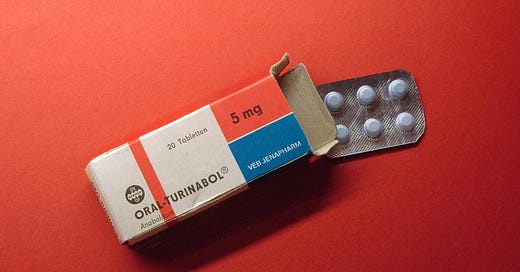Doped then, transitioned now.
The East German doping scandal is a tragic blueprint for the health effects of testosterone on female bodies. If known more widely, it could help both detransitioned and trans-identified women.
Important disclaimer: Even though some of the health outcome statistics look grim, I want to stress that this article is neither supposed to be sensationalist nor to instill fear on currently trans-identified females, detransitioned females or their parents. I have nothing but empathy for those suffering from the fallout of medical transition. But I think it is crucial that these statistics are known for two particular reasons. First, they dispell the claim that ‘gender-affirming care’ is life-saving and medically necessary and can serve as a counter-argument whenever it’s raised. Second, knowing about the health risks could be important for specialized medical care for detransitioned and trans-identified women and hence improve their quality of life.
The extent of testosterone ‘treatment’
Transactivist organizations, doctors, and medical associations across the globe have claimed that puberty blockers and cross-sex hormones—key components of so-called “gender-affirming care”—are life-saving, harmless, and that any restriction on access will inevitably harm “transgender youth and adolescents.” However, we now know that puberty blockers are far from benign. They almost invariably lead to sterility and are associated with reduced bone density and impaired cognitive development. The health risks posed by cross-sex hormones, by contrast, remain comparatively underexplored.
At first glance, it seems naive to assume that a girl’s (or boy’s) body—hormonally primed by estrogen (or testosterone) even before puberty and biologically designed to follow that trajectory—would remain equally healthy when this developmental pathway is interrupted and flooded with high doses of opposite-sex hormones. Given testosterone’s potency and the predominance of females in trans-identifying adolescent cohorts, this question is particularly urgent in the case of testosterone treatment for girls.
Tens of thousands of girls and women worldwide have received testosterone as part of medical transition from female to male. A recent study by JAMA Pediatrics found that in the US alone between 2018 and 2022 around 1 in 1,000 privately insured minors were prescribed cross-sex hormones—with the majority being testosterone for girls. Extrapolating this figure to the broader U.S. minor population suggests that roughly 56,000 girls received testosterone prescriptions in that period alone.
While the U.S. represents the central battleground in the gender culture wars, pediatric sex-trait modification occurs globally. In the UK, nearly 2,000 children received puberty blockers through the Gender Identity Development Service (GIDS)—most of whom likely went on to take cross-sex hormones. When adding the private medical sector to the tally, the number rises sharply. Repeating this estimation across Europe and Canada suggests that hundreds of thousands of girls have likely had their bodies altered by male sex hormones—often irreversibly. Understanding the long-term health consequences of this practice is therefore an urgent public health imperative.
One historical precedent may offer insight: the mass-scale administration of androgens to young athletes in East Germany.
The Eastern German doping scandal
Demonstrating socialist superiority was a key objective for the governments of the Eastern Bloc. Failing to do so economically or politically, they turned to international sports as a proving ground. With the advent of synthetic hormones, state officials began boosting the athletic performance of both male and female athletes using anabolic steroids and synthetic testosterone.
The results of this cynical experiment were striking: East Germany—a nation of just 16 million—outperformed the United States and ranked second in the medal count at the 1988 Summer Olympics.
Doping was already common in the 1950s and 1960s, but largely limited to stimulants like amphetamines. In 1974, the regime launched the systematic Staatsplanthema 14.25 (State Plan 14.25), aiming to enhance performance across all international competitions. Both boys and girls—often unaware—were administered anabolic steroids, most notably Oral-Turinabol, a synthetic derivative of testosterone. Doping often began between ages 12 and 14.
Oral-Turinabol was designed to maximize muscle-building (anabolic) effects while minimizing masculinization (androgenic) traits. The intent was to boost strength—especially in female athletes—without making them look “too male.” In the end, it is estimated that at least 10,000 athletes received androgen doping with the majority of them being female.
A blueprint for the mass-medicalization of gender distressed girls
To assess whether this doping scandal offers a meaningful precedent for understanding the long-term health consequences of testosterone in trans-identified females, two criteria must be met:
The substances involved must be comparable in effect and dosage.
The age profiles of the affected individuals must be similar.
On the first count, the overlap is striking. Anabolic steroids like Oral-Turinabol are testosterone derivatives and produce similar virilizing effects in women. A 2024 summary of the East German doping scandal listed common side effects reported by female athletes — many of which closely resemble those described by female detransitioners today:
Disruption of the menstrual cycle, including a complete absence of the period (amenorrhea)
Increased cyst formation
Uterine and vaginal atrophy
Irreversible deepening of the voice, increased hair growth
Excessive increases in libido
Increased aggression and impulsive behavior
While anabolic steroids are often considered more harmful than pure testosterone, this judgment usually derives from therapeutic use in men with clinically low testosterone levels. In gender transition, however, the goal is masculinization—so doses for trans-identified females are often significantly higher and administered continuously over many years and sometimes for the rest of life. By contrast, East German athletes typically received hormones for less than a decade. In this context, the health outcomes of steroid doping may well represent a lower bound for the risks associated with gender transition.
The second condition is also met: Doping in East Germany generally began in adolescence. Similarly, WPATH guidelines recommend testosterone no later than age 16, with many practitioners initiating treatment as early as 14.
While psychological consequences may be harder to compare—given that East German athletes were coerced while trans-identified females often request testosterone—the body does not care about intent. From a physiological standpoint, the impact of male sex hormones on female bodies is largely the same regardless of motivation.
Testimonies affected women: Chronic illness, birth defects and trans-identification
Consider the case of Birgit Pabst, a former shot-putter. Told she was receiving vitamin supplements, she soon experienced classic signs of masculinization: a deepened voice, excess hair, and rapid muscle growth. When she later failed to conceive, her doctor discovered her uterus was developmentally equivalent to that of an 11-year-old. Only after prolonged treatment with female hormones was she able to have a child. Today, she suffers debilitating joint pain and requires morphine daily.
Katja Hofmann, a former discus thrower, lives with severe liver damage, hypertension, cysts, joint pain so intense she vomits from the pain, and underdeveloped reproductive organs. In a 2018 Die Zeit interview she stated that while she “loves life,” she doubts it will be a long one.
In a disturbing parallel to the testimonies of detransitioners today, many athletes today say that there is a strong sense of shame and guilt. Many endured years of guilt and shame before speaking out, describing the experience as "liberating" and crucial to healing—eerily similar to the testimonies of detransitioners today.
In some cases, the next generation was also affected. Nicole S., a rower doped from age 12 developed severe heart and liver cancer in her early 20s. Her son was born with epilepsy, ADHD, asthma, and fine motor impairments. This does not seem to be an isolated incident: The advocacy group for doping victims DOH (“Doping-Opfer Hilfe”) is aware of at least 300 such cases involving birth defects—ranging from hydrocephalus to malformed limbs. The German sport historian Giselher Spitzer noticed early on that among affected women, unusually many suffered from miscarriages and stillbirths. And if their children made it to the world alive, an unsually large proportion continues to suffer from chronic illnesses
The effects across generations is maybe not surprising when you consider what testosterone (and to that extent also anabolic steroids) do to the female reproductive system. Testosterone and its derivatives cause uterine atrophy, increasing the risk of infections and impairing fertility. Just watch this interview with the Scottish physiotherapist on the Gender - A Wider Lens Podcast for a more detailed explanation.
The female shot putter Andreas (formerly Heidi) Krieger, was exposed to large doses of anabolic steroids and testosterone in the 1980s and began to masculinize visibly (see pictures above). After years of confusion and distress in post-unification Germany, Krieger stated that living as a woman made no more sense in the now united Germany and began to identify as a man. Krieger underwent the old path of gender recognition under the German Transsexual Law and changed the sex entry to male. Back then, this required ‘sex-reassignment’ surgery. Krieger does not make any claim about a male gender identity. Rather and tragically it seems, that years of extensive forced masculinization made it impossible to reconcile with being a woman.
What the research says
There have been a variety of attempts to measure the health effects of the East German doping scandal. Most studies, however, rely on self-selected samples because the people studied came forward by themselves. For instance, people who have stronger health complications might be more eager to speak out than those with only mild impacts on their well-being. The findings of these studies should therefore always be taken with a grain of salt in that they might overestimate the negative health effects.
However, the long-term health complications are shocking. Here is a selection of studies. Whenever possible, I will restrict findings to female athletes. However, when it comes to cardiovascular and oncological side effects, I could not find any reasonable argument why the effect should be dependent on whether the athlete was male or female.
A 2023 case-control study (comparing doping victims to the general population) finds that relative to people of similar age who have not undergone doping, athletes who were given androgens exhibit statistically and clinically significant elevated rates of depression, chronic stress and a severe reduction in physical well-being. The effects are similar for both sexes.
Together with the doping victim advocacy group “Doping Opfer Hilfe e.V.”, the German psychologist Harald Freyberger analyzed health records of former athletes that came forward and found that previously doped athletes died on average 10-12 years earlier than the general population and were 2.7 times more likely to be physically ill.
A 2018 study found that 25 % of doped athletes suffered from cardiovascular disease, 27 % had tumors and 27 % of female athletes suffered from gynecological problems
A 2024 study found that 21 of 56 female athletes suffered from miscarriages, 50 out of 56 suffered from gynecological problems. The athletes today are on average 55 years. Overall, 25 of 107 athletes had cancers in various forms, 35 out of 107 heart issues, 10 out of 107 were epileptic, 13 out of 107 had lung issues and 94 of them were suffering from joint pain.
The advantage of looking into these studies is that it clearly points to the long-run effects of male hormones. Research into ‘gender medicine’ is hopelessly flawed in that even if there is any follow-up, it often stops after one year for no good reason. So even if there are some differences between steroid doping and gender transition, knowing these numbers is useful.
It’s useful not to instill fear or to be sensationalist. It’s useful to develop adquate medical care for those having detransitioned and also for those who are still taking testosterone. Medicine has evolved greatly in the last decades, so maybe we can spare those women some of the health conditions that nowadays plague former athletes. Medical associations and activist doctors around the world still claim that ‘gender-affirming hormone therapy’ is life-saving. The numbers above make a mockery of these claims and can be another useful argument to unravel the house of cards that is gender medicine.





